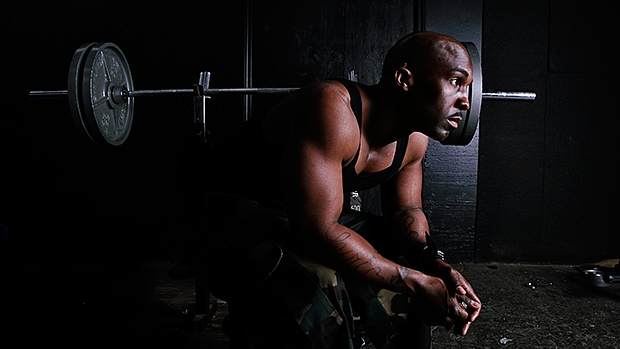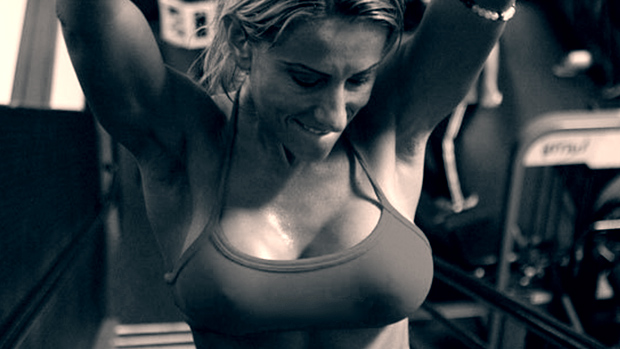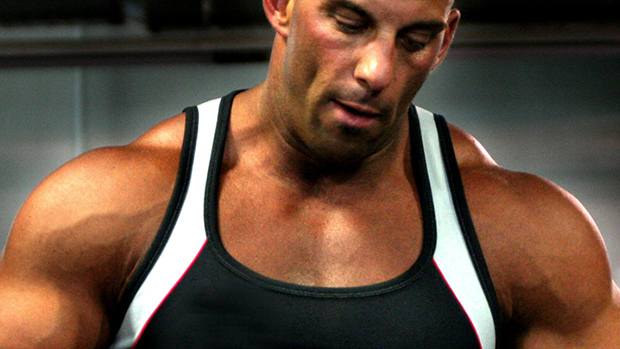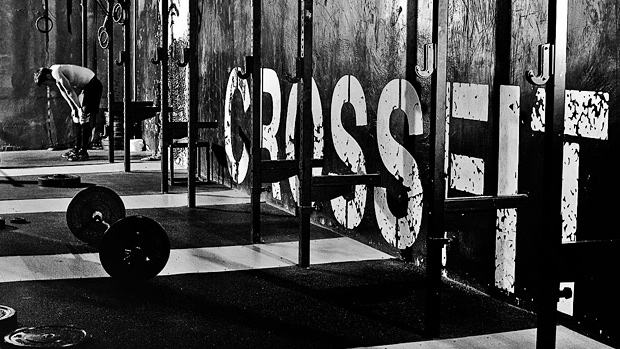Knives vs. Missiles
"If you put a group of the most successful strength coaches in one room and their students in another, the students wouldn't agree on any training philosophy or principle, whereas the coaches would agree on almost everything."
I've said a couple of times that people tend to focus too much on the differences between coaches' philosophies rather than the similarities, where the real information is.
For example, I don't think there's a single successful coach who thinks that frequency, intensity, and overload aren't valid training principles. Or one who feels that basic compound free weight exercises shouldn't be the cornerstone of your strength program.
And everyone agrees that a shitty program done with good form and intensity will outperform the perfect, periodized routine done with shitty form and zero intensity.
At a seminar I attended recently, Mike Boyle mentioned that there are a lot of people out there who want to subscribe to a training philosophy, but very few who actually take the time to develop one. This was one of those "ah-ha" moments for me. I began to think of how I developed my own training philosophy and how I could share that with readers looking to do the same.
One of Mike's own examples was that he has discontinued back squats with his athletes in favor of front squats based on what he's witnessed over the years as a coach.

Whether I or you or Internetstud123 agrees is unlikely to sway Mike. What is probably true though is that given the same experiences, and the same athletes, over the same period of time, most of us may have come to similar conclusions.
A training philosophy is shaped from your own observations, experiences, and studies. You can't say "that's wrong" because unless you have the exact same experiences, you're coming from a different reference point.
Which is a better weapon, a knife or a missile? At three feet, it's a knife. At one mile it's a missile. Different reference points, right?
My Philosophy
I guess my philosophy is still the Bruce Lee line: "Absorb what is useful; reject what is useless." I'm sure you're all sick of hearing that.

I don't have an "angle." I'm not the EDT guy, I'm not the total body guy, I'm not the HSS-100 guy, and I'm not the mobility guy.
In fact, in the first interview I did for T-Nation, Chris Shugart asked me what my training philosophy was. Here was my answer:
"Why do I have to be a functional training guy? Or an Olympic lifting guy or a Westside guy? Am I a HIT guy? No. Does that mean I'm a low intensity guy then? Absolutely not. I'm all of those and I'm none of those. I'm a results guy. I guess my philosophy is 'Results by Design, Not by Coincidence.' Get the best results in the least amount of time. The faster I can get results, the more I get paid."
And I guess that's it in a nutshell. I'm only interested in using tools and methods that can produce the intended result faster than any other method.
With all this said, here are some of the ideas that have shaped my philosophy and will continue to have an influence on me, and some of the things that you need to consider when developing your own.
Warning: Keyboard warriors take note – these are based on my experiences. If your experiences are different, you will, based on those differences, have come to a different conclusion. That doesn't mean you're right and I'm wrong, just that we have different experiences that have influenced us.
1 – Look at the Majority
I'll throw out some theoretical numbers here. Probably around 80-90% of the population, 80-90% of the time, will respond best to total body workouts. And I'd say that maybe 90-95% of the population, 90-95% of the time, will respond best to either total body or an upper and lower split.
This is something that I'm unlikely to be swayed on. In my own experience (and in the experiences of the coaches I respect), this is what I've found over time to be true. Now, the numbers may not be exact, but if you read what I said as "the majority of people," you'll see what I mean.
But also make sure to read my entire statement. I'm also saying that 10-20% of the population will not respond best to total body workouts, and that 10-20% of the time these programs won't work. There's definitely room in my philosophy for other approaches, but I'm comfortable with the "most of the people, most of the time" part.
Recently, the whole split routine vs. total body vs. body parts argument has been hotly debated on this site. The problem is, there can't be an answer that's 100% correct, 100% of the time, for 100% of people.
Ask yourself if an advanced, genetically gifted, full-time professional bodybuilder falls into my 95% of the population? No way! But ask yourself what a 40-year-old female beginner who could train only twice a week would respond best to? She falls into the middle of the majority, right?
What I've found amusing though is that it seems 90% of people think that they're in the advanced 10%. As John Berardi once said:
"Even at an elite level of athleticism, there are only 10% of people who need to stress over the details. Most people think they're there when they're not. You have to understand whether you're a part of the 90% or the 10%."
Overall I think most people will agree with the point I'm making, but the smaller minded ones will argue about the percentages. That's cool though. Lets me know quickly who's worth talking to.
2 – Think of the Average (because that's where the big picture is)
What a pro-bodybuilder or professional athlete responds best to has little meaning for most of us. Most of us aren't at elite levels. Most of your clients aren't at elite levels. So develop concepts based on what works, most of the time, for the average person.
For example, over time I've found that a drug-free individual with a job or school, training for size, needs to work a muscle more than once a week for optimal results. And that same individual usually doesn't recover from more than two back-to-back weight training workouts effectively.
A program that works for a steroid-using athlete training six days per week won't work for a drug-free father of two who works 40 hours a week and gets to the gym for three hours total... or vice versa.
A program that works great to physically prepare a 17-year-old figure skater for a regional championship won't work to prepare a super-heavyweight powerlifter for the WPO's... or vice versa.


Here's an interesting thing I've also witnessed: when it comes to isolation exercises, the average person seems to respond better to one set of three different exercises than to three sets of a single exercise. Just my observation.
But I just read a quote from Luke Wood (IFBB pro) who stated that he felt his calves responded better to 8-9 sets of one exercise rather than multiple exercises. Does that mean one of us is wrong? No, just that our philosophies are different based on our own experiences.

For most of us, understanding what works for the average person will generally yield far greater rewards than focusing on what works for the few.
3 – Respect the Laws of Physiology
Training is a physiological stimulus. Therefore you must have a physiological basis for your training philosophy. For example, if you don't apply overload in your training program, you won't progress. These are basics.
I have no problem with you doing an intense aerobic program. But if you're doing an intense aerobic program to gain arm size, then you're breaking the laws of physiology. Similarly, I have no problem with five day splits or any such sequence of training your body. I'll confess though that I still have a problem with "body part" based splits.
I've read the Weider system and Arnold's book. I've read pretty much every fitness and bodybuilding magazine that's been released over the past twelve years. I still can't see any rhyme or reason to the allocation of body parts to a training day. It seems completely arbitrary to me. That doesn't mean split training is wrong or doesn't work; I just can't see how there are any solid guidelines there based on physiology. It's hard to shape a philosophy around that.
Do I use further splits than just upper/lower? Of course. But (similar to Ian King) I'm concerned with loading parameters through each joint and prefer to use a loading classification that takes that into account to help prevent non-impact injuries. So I try to match antagonistic joint movements within each workout (e.g. horizontal push and pull around the shoulder girdle).
Is this a better way? Who knows? But at the very least it's based on joint and muscle action and movement (i.e. physiology and biomechanics) and it's been a great way to practically eliminate all training induced injuries with our clients.
4 – It's Not About Equipment
A tool isn't a training philosophy. You can't be a "kettlebell guy" or a "Swiss ball guy." That makes no sense. Kettlebells are a tool, a weight; they are not a training philosophy.
You can't build an entire approach to training around a piece of equipment. There's no physiology there. You can only build that system around the human body.

And for the last time, kettlebells, Swiss balls, chains, logs, sandbags etc, are not things you do. They are things you buy. Develop your ideas regardless of your access to equipment.
5 – Time Management Comes First
Real world time commitments should definitely be a factor in shaping your philosophy. The bulk of my clients over the years have been athletes and regular people. For a national level bodybuilder, or any athlete for that matter, training is a way of life. Their entire eating, moving, and sleeping habits are built around supporting their training.
I have a client who's a doctor. His life does not and cannot be designed to support his workouts. Similarly, most people I've worked with have had serious time commitment issues. They can only get to the gym for three hours per week, or can only get two sessions in per week because of practices and game schedules. So over the years I've come to realize that there are certain things I'd like to do with clients that just aren't practical due to time.
One of those is straight sets. I can rarely do them. For time management reasons, I always use the alternating set system. I've yet to hear a convincing argument for the superiority of straight sets in the situations I described. I tend to do exercise one for a set, rest 60 seconds or so, exercise two for a set, rest 60 seconds or so, and continue.
I think that when designing programs you should start with the time available first and then develop a program around it. Don't develop your program and then try to fit it into the available time.
6 – Know What "Advanced" Really Is
You have to be advanced before you do an advanced program. A 140 pound 14-year-old kid doesn't need Jay Cutler's program, just as a JV basketball player doesn't need an NBA All Star's current routine.
Most of the time, people are looking for advanced routines before they're ready. I received an email once from a guy asking how I'd adjust a fat loss program I'd written for an "advanced individual" such as himself. When I inquired as to his stats, it turns out this "advanced" guy was 160 pounds at 22% body fat.
Just because you've posted on a website 5000 times doesn't make you advanced.
So when working on your own philosophy, you may need to differentiate for advanced individuals. It's true that the method used to take you from a 315 pound squat to a 405 pound squat might not work to take you to a 495 pound squat, but again, there will be more similarities than differences.
7 – Stand on the Shoulders of Giants
Don't ignore the lessons of those that have gone before you. This can save you a lot of time and effort and help "fast track" you. You don't have to start from scratch.
For example, I greatly respect Eric Cressey and Mike Boyle. Eric only graduated college about three years ago. Mike was a full time strength coach before Eric was born. If Mike and Eric disagree on something, then generally Mike's experience has more weight. (It doesn't mean Eric's opinion is worthless; it's just that 25 years of practical experience tends to count for a lot more as far I'm concerned.)
Note: This has become too much of a Mike Boyle appreciation society bulletin. So in the interests of balance – Mike sucks.
Keep that in mind when shaping your own ideas. Steal. Steal and modify. It's not "cheating" to use the experiences of others to better yourself. As Tony Robbins says, "Whether you want happiness, financial independence, better relationships, or your dream body, know that somewhere someone mastered this area. And by modeling what they did, you too can experience the same results."
8 – Form is King
For the majority (there, I said that word again), a focus on excellent technique when lifting is paramount.
Yes, I know that [insert pro bodybuilder here] on his DVD just throws the weights around and looks great. But as I've said, you are unlikely to benefit from blindly following that approach because you aren't a pro-bodybuilder. In fact, you're more likely to get injured than get jacked.

Ignoring proper technique as the foundation for your exercise programs is a huge mistake.
9 – Exercise Selection
Just as Mike prefers the front squat to the back squat, and Charles Poliquin prefers the dumbbell row to the barbell row, you must also have some general guidelines when it comes to exercise selection.
Here are some of mine:
- Bodyweight variations before external loading
- Ground based
- Standing variations instead of seated
- Free weights rather than machines.
We also tend to favor a hierarchy of exercises, where a chin-up is always selected over a lat pulldown (we use flex bands when we need to get more reps). And we make sure to target all the primary movement patterns – squat, lunge, bend, push, pull, and twist.

So develop a general hierarchy of exercises. If time is tight, do you need back squats, front squats, sissy squats, hack squats, and leg presses? If you only had time for one, which one would it be? Think like that with regards to all movements and muscle groups.
I think most people will end up with an array of exercises that are predominantly compound free weight movements with a few isolation exercises and maybe a few machines. And it's fair to say that regardless of your goal, that will probably serve you well.
10 – TiVo the Workout
TiVo is a digital video recorder that allows you to tape shows and watch them later.
The beauty of it is that you can watch a one hour show, cut out the commercials, titles, and credits, and get all the meat of the show in about 40 minutes. In other words, you eliminate the BS. You can either watch the same amount of TV in less time or you can get more TV in.
So one of my philosophies is to try to eliminate the BS in the workouts. Time the rest periods to make sure they aren't too short or too long. Sequence the exercises to maximize the benefits and eliminate any redundant movements. This allows us to shorten the workout and get out of the gym faster, or to find more time for some more exercises.
Eliminate any redundancy or wasted time in your or your clients' workouts.
11 – Assess, Assess, Assess
If one year ago you were 205 pounds and 15% body fat and now you're 206 at 14% body fat, unless your goal was to "maintain," then your training program and philosophy needs an overhaul.
If for five years you've tried to qualify for the nationals in your sport and failed – and always used X training and Y diet – then it's fairly likely that X training plus Y diet will fail again this year. Your plan didn't work and is unlikely to magically start working now.
I think a training philosophy is a dynamic process and never ends. You may have read something of mine from a year ago that contradicts what I'm saying now. I'm fine with that. I'm still a student and reserve the right to learn and continually let my thinking evolve. In fact, if you haven't changed your mind about something over time, then I worry about you.
Make sure you keep records and continuously assess the results of your programs. Refine them constantly.
12 – Tweak, Tweak, Tweak
I've talked a lot about the majority and developing a philosophy to target your client groups. But what if you are the only client? Then you need to individualize and tweak your philosophy so that you know what works for you.
Establish where you are. Are you advanced? A beginner? How much time can you commit to training? Who's started from a similar place as you, with similar conditions, and already reached the goals you've set? Who has trained people like that? What are the commonalities of the programs and the approaches? What can you take home and use to help shape your own philosophy and design your own program?
If you hire me as your trainer, I'm constantly asking for feedback. Our goal is to use both our minds together to develop a strategy to help you reach your goals.
I don't know you. Everything I decide to do with you is a guess. Granted, it's an educated guess based on several years experience, but it's still just a guess. You have to tell me if this routine hurts your knees, isn't working for you, or leaves you too tired to do anything else all day and we will adjust it. Training is a process, not a prescription. A good coach is always interested in what his clients have to say.
The idea is to use your experience plus the coach's experience to reach new heights. You came in with a problem and together we're looking for a solution. But I need to know what you've tried in the past – what's worked and what hasn't.
Don't ignore your own knowledge. Don't ignore anyone's in fact. If a writer says, "Dips are the best upper-body exercise" they probably mean "for most people, most of the time." Don't follow that blindly.
For you, dips might hurt like hell and just leave you with sore shoulders. Only you know. So take that advice and tweak it based on your own (or your clients') experiences.
Summary
The bottom line is you have to look at everything critically, with an open mind, and see the pros and cons of every approach. Question everything, but first look at everything. As Mike Boyle says, don't believe everything you read, but definitely don't just read everything you believe.
Overall, develop a philosophy first and a program second. Remember the basic training principles and laws of physiology. Analyze goals and objectives and put the pieces together.
In closing, it's back to Bruce:
"Use no way as way, use no limitation as your limitation."
And...
"Liberate yourself from the classical mess."




